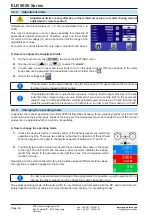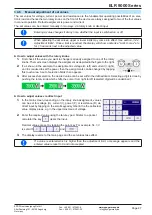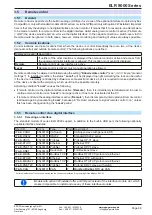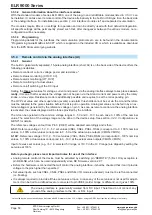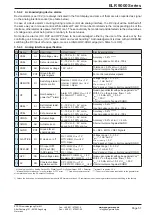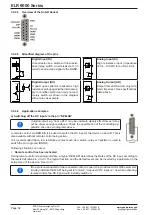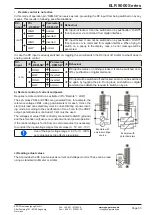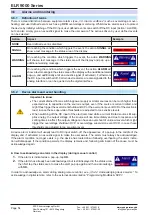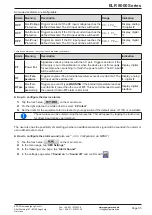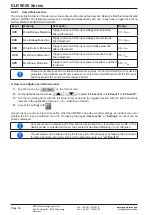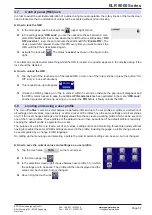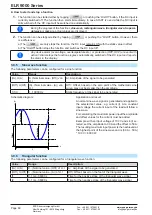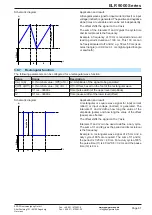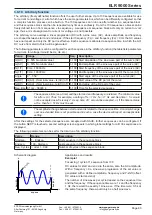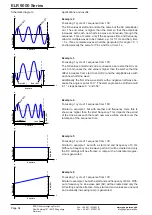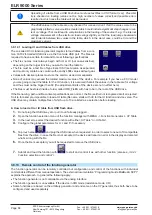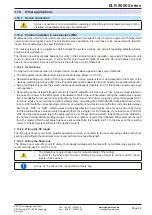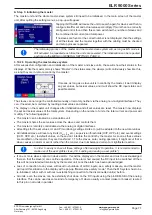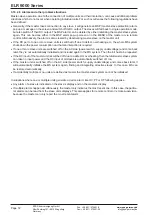
Page 58
EPS Stromversorgung GmbH
Alter Postweg 101 • 86159 Augsburg
Germany
ELR 9000 Series
Fon: +49 821 / 570451-0
Fax: +49 821 / 570451-25
3.9
The function generator
3.9.1 Introduction
The built-in function generator is able to create various signal forms and apply these to the set value of voltage
or current.
In manual operation, all generator functions are available for access on the front panel. In remote control, only the
customisable arbitrary generator and a XY function are available. The arbitrary generator can replicate all manually
serviceable functions, except UI and IU. For those, the XY function is assigned.
The following functions are retrievable, configurable and controllable:
Function
Usable
on
Short description
Sine wave
U, I
Sine wave generation with adjustable amplitude, offset and frequency
Triangle
U, I
Triangular wave signal generation with adjustable amplitude, offset, gain and decay times
Rectangular U, I
Rectangular wave signal generation with adjustable amplitude, offset and duty cycle
Trapezoid
U, I
Trapezoidal wave signal generation with adjustable amplitude, offset, rise time, pulse
time, fall time, idle time
DIN 40839
-
Simulated automobile engine start curve according to DIN 40839 / EN ISO 7637, split
into 5 curve sequences, each with a start voltage, final voltage and time
Arbitrary
U, I
Generation of a process with up to 100 freely configurable steps, each with a start and
end value (AC/DC), start and end frequency, phase angle and total duration
Ramp
U, I
Generation of a linear rise or fall ramp with start and end values and time before and
after the ramp
UI-IU
-
Table (.csv) with values for U or I, uploaded from a USB flash drive
With R/I being activated, access to the function generator is not available.
3.9.2 General
3.9.2.1 Limitations
The function generator is not accessible, neither for manual access, nor for remote control, if
•
master-slave mode has been activated and the device was configured as slave.
•
resistance modes (R/I adjustment mode, also called UIR mode) is active.
3.9.2.2 Resolution of X (time) and Y (amplitude)
The function generator can set 4096 steps between 0 ... 100% of any nominal value. The intervals to create a
linear or other rise/fall are calculated depending on the amplitude and then set.
If the amplitude is very low and the time long, only few intervals will be set as otherwise many identical values will
be set one after another, generating a staircase effect.
3.9.3 Method of operation
In order to understand how the function generator works and how the value settings interact, the following should
be noted:
The device operates always with the three set values U,I and P, also in function generator mode.
The selected function can be used on one of the values U or I, the other two are then constants and have a limit-
ing effect. That means, if, e.g. a voltage of 10 V is applied to the DC input and a sine wave function should oper-
ate on the current with an amplitude of 20 A and offset 20 A, then the function generator will create a sine wave
progression of current between 0 A (min) and 40 A (max), which will result in an input power between 0 W (min)
and 400 W (max).The input power, however, is limited to its set value. If this were 300 W then, in this case, the
current would be limited to 30 A and, if clamped to an oscilloscope, it would be seen to be capped at 30 A and
never achieve the target of 40 A.
Another case is when working with a function which is applied to the input voltage. If here the static voltage is
set higher than the amplitude plus offset then at function start there will be no reaction, as the voltage regulation
limits down to 0 with an electronic load, other than current or power. The correct settings for each of the other set
values is therefore essential.



